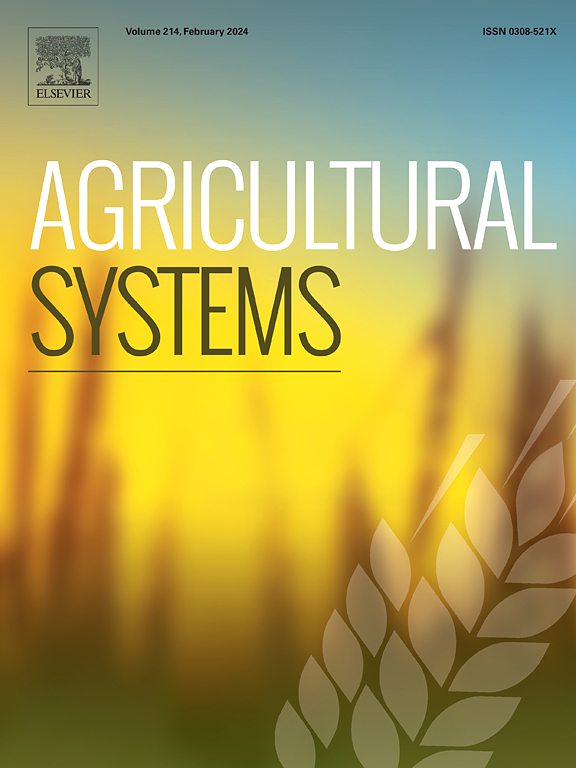Can using food waste as feed reduce the environmental footprint of Canadian beef production? A case study of cull potatoes
IF 6.1
1区 农林科学
Q1 AGRICULTURE, MULTIDISCIPLINARY
引用次数: 0
Abstract
Context
Food loss and waste (FLW) originating from food production and subsequent agro-industrial processing and distribution is receiving increased attention as it impacts social, economic and environmental sustainability. It also results in inefficient use of land, water, and energy, contributing to greenhouse gas (GHG) emissions and habitat degradation. The use of FLW as livestock feed is one solution to address these environmental concerns as well as reducing the food-feed competition.
Objective
This study was designed to evaluate the feed conversion ratio (FCR), land use requirements and GHG emissions of cattle management systems (calf-fed, yearling-fed and yearling-grass fed) offered: i) barley- and corn-based standard (STD) diets or ii) STD diets in which cull potatoes replaced barley and corn at 15 % and 30 % dry matter (DM) basis.
Methods
Feed conversion was calculated as kg DM intake (DMI)/kg beef protein (BP; R1); kg human-edible (HE) DMI/kg BP (R2); kg protein DMI/kg BP (R3) and kg HE protein DMI/kg BP (R4). Corn and barley grain were either assumed to be grown on-farm (Scenario 1) or transported (Scenario 2) from an adjacent Ecodistrict. Further, in each scenario, emissions were estimated by considering no emissions from potato productions or 10 % emissions based on economic allocation. The Holos model and published coefficients that impact GHG emissions were used to estimate GHG emissions including those from diversion of cull potatoes from landfill.
Results and conclusions
Among FCR metrics, R2 and R4 provide meaningful measure of the value of cull potatoes in feedlot diets, representing the portion that would not be consumed by humans and wasted otherwise. Compared to STD diets, inclusion of cull potatoes at 15 % and 30 %, led to a 12–15 % and 24–30 % reduction in land use, respectively. Total GHG emissions were also reduced by up to 5 % and 22 % in Scenarios 1 and 2, respectively. In conclusion, incorporating cull potatoes in feedlot diets can improve FCR, reduce land requirements and GHG emissions, and avoid the CH4 emissions that would arise if they were sent to landfill.
Significance
Inclusion of non-conventional feeds such as FLW could serve as a first step in addressing the FLW challenge as well as providing alternative feedstuffs during feed shortages resulting from flood or drought.

求助全文
约1分钟内获得全文
求助全文
来源期刊

Agricultural Systems
农林科学-农业综合
CiteScore
13.30
自引率
7.60%
发文量
174
审稿时长
30 days
期刊介绍:
Agricultural Systems is an international journal that deals with interactions - among the components of agricultural systems, among hierarchical levels of agricultural systems, between agricultural and other land use systems, and between agricultural systems and their natural, social and economic environments.
The scope includes the development and application of systems analysis methodologies in the following areas:
Systems approaches in the sustainable intensification of agriculture; pathways for sustainable intensification; crop-livestock integration; farm-level resource allocation; quantification of benefits and trade-offs at farm to landscape levels; integrative, participatory and dynamic modelling approaches for qualitative and quantitative assessments of agricultural systems and decision making;
The interactions between agricultural and non-agricultural landscapes; the multiple services of agricultural systems; food security and the environment;
Global change and adaptation science; transformational adaptations as driven by changes in climate, policy, values and attitudes influencing the design of farming systems;
Development and application of farming systems design tools and methods for impact, scenario and case study analysis; managing the complexities of dynamic agricultural systems; innovation systems and multi stakeholder arrangements that support or promote change and (or) inform policy decisions.
 求助内容:
求助内容: 应助结果提醒方式:
应助结果提醒方式:


